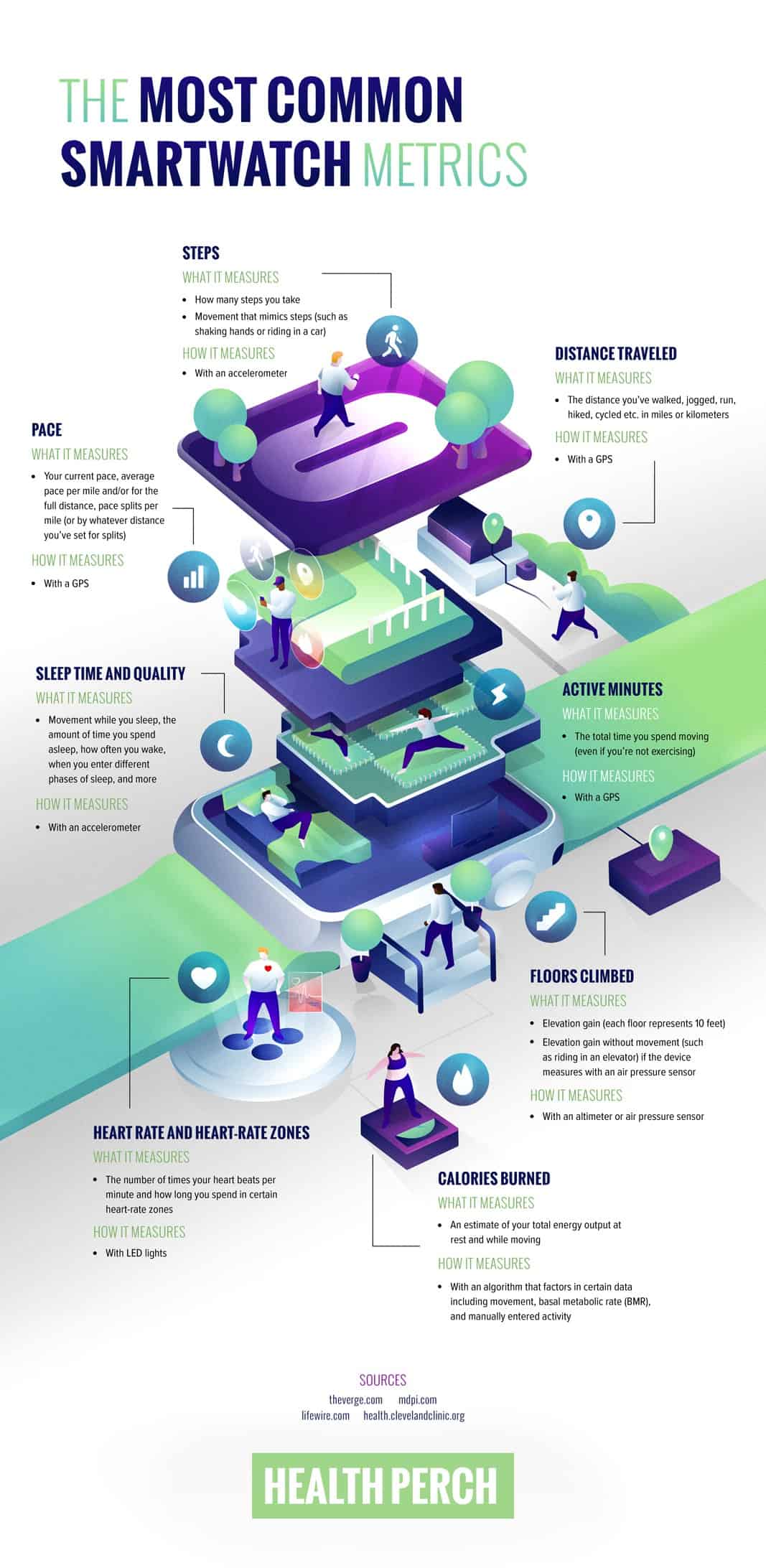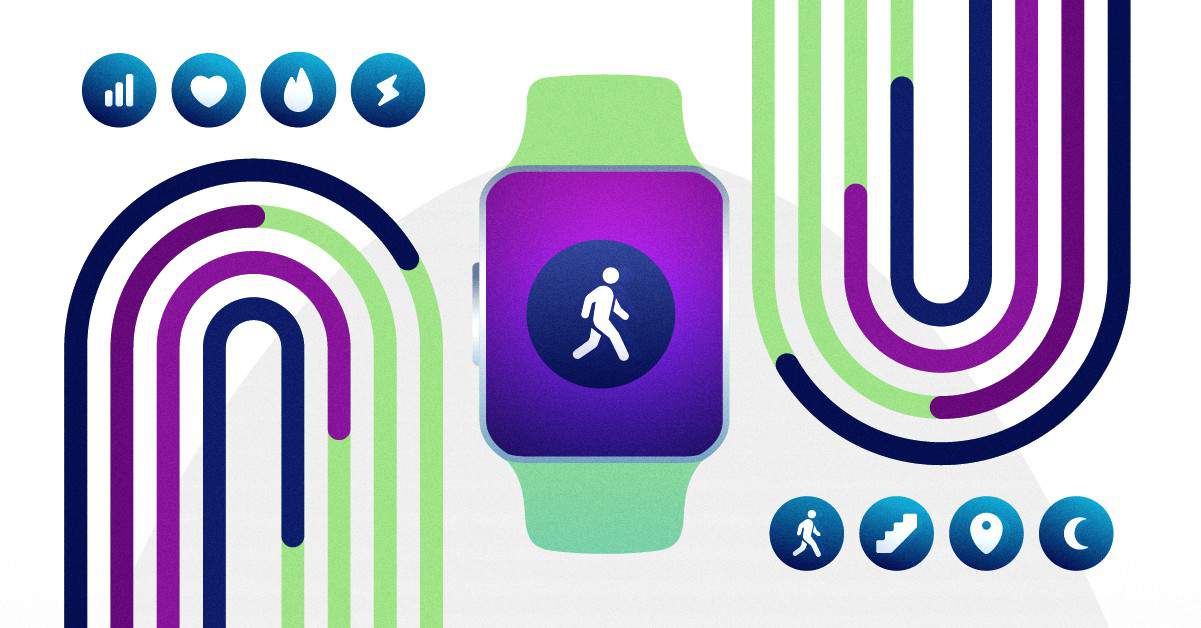Smartwatches, wearables, fitness trackers: They go by many names, but whatever you call them, the movement-measuring devices so many of us wear on our wrists can capture more data than ever.
And that’s the point, right? We want to track everything from how many steps we’ve taken to our stress levels, calories burned, and more.
But here’s the problem. Most people aren’t entirely sure what those measurements actually mean. Even if they do, smartwatch users may learn that certain metrics mean more when looked at as part of longer-term trends rather than in a vacuum.
Additionally, several studies show that trackers may not be as accurate as users would hope for all metrics. In one study, researchers found that most trackers measured heart rate fairly well, but produced far less reliable calorie burn results. This lack of accuracy may not be a huge surprise to anyone who’s switched from, say, a Fitbit Ace to an Apple Watch or Garmin vivoactive and noticed vastly different measurements for heart rate, step count, and sleep — despite making no behavioral changes. That’s because different watches may not only use different tech, but they may also analyze the data collected with their own algorithms.
If you want to use your tracker to gain a deeper understanding of your health and habits, it’s generally important to pay closer attention to overall trends in data collected by the same device rather than fixate on a single outlier collected on a specific day. With all that said, it’s worth understanding what types of metrics your wearable can collect and how to do your part to ensure your device takes the most accurate measurements as possible.

Common Smartwatch Metrics
With so many brands offering a variety of smartwatches, the considerable diversity of metrics tracked makes sense. If you want to focus on a specific measurement, make sure the wearable you select can calculate it. After all, you can keep tabs on your fertility, stress levels, and sun exposure with certain trackers, but know that not every watch covers each of those areas.
Here are a few the most commonly tracked metrics along with why each data point may be useful.
Steps
Nearly every activity tracker will count your steps; in fact, your phone probably does, too. Most devices use an accelerometer (which measures acceleration) to track your movement and often come pre-set with a daily goal of 10,000 steps a day — the equivalent to roughly five miles. And while you could aim for a specific number, you could also simply note how many steps you naturally take on a given day and compare the average number you hit on a workday with your total for a weekend day. Then, use that as motivation to add in a few more steps as needed!
Also, keep in mind that lots of unintentional movements can affect this number. Riding in a vehicle, for example, can add hundreds of steps to your day.
Floors climbed
Another common measurement, floors climbed, uses an altimeter (which measures altitude) to gather elevation-related data. Those who live in a hilly area or a building with stairs may see this number climb quickly, while flatlanders in a single story home may see very little change on a regular day. Keep in mind that some watches use air pressure changes to track floors climbed, so certain activities, like riding an elevator, can ramp the number up despite you standing in place.
Calories burned
Whether you’re counting calories as part of a weight-loss journey or keeping an eye on how many you burn in a workout, you may be glad to know that most fitness trackers offer this insight. However, as mentioned above, most trackers do not estimate calorie burn effectively, so be careful not to put too much stock in the specific numbers you see.
Heart rate and heart-rate zones
While trackers falter in accuracy in some areas, they tend to gather accurate heart rate data, although it’s generally accepted that a wrist-based heart rate monitor is less effective than a chest strap. Not all devices offer heart-rate tracking, but certain users — including runners — find this function especially helpful. Changes in average resting heart rate as well as the amount of time a person spends in each heart-rate zone during a workout can provide valuable feedback in a training cycle and help athletes avoid overtraining.
Distance traveled
Whether you’re cycling, running, walking, hiking, training for a race, or simply want to see how far along a route you’ve traveled, you would benefit from a wearable that calculates distance traveled. Typically, a built-in GPS provides this data.
Pace
Many athletes look for pace metrics, an additional data set provided by GPS. With pace tracking, you’ll likely be able to view your current pace, average pace per mile and/or for the full distance, and pace splits per mile (or by whatever distance you’ve set for splits).
Active minutes
In addition to the ability to track specific workouts, most smartwatches also log your active minutes, which tallies the total time you spend moving (even if you’re not necessarily exercising).
Sleep time and quality
Lots of wearables include accelerometers that sense your movement while you sleep and offer insight into the amount of time you spend asleep, how often you wake, and even when you enter different phases of sleep. Some even track environmental factors such as light and temperature, or prompt you to enter lifestyle factors (like caffeine intake, when you ate, or stress level) in order to help you understand what may be affecting your sleep.
How to Improve Your Smartwatch’s Accuracy
Even though you now understand why it’s more useful to look at your data in terms of trends rather than analyze the numbers from a specific day, it’s still helpful to know a few ways to help your device track more accurately. Fortunately, a few simple strategies — starting with reading the device’s manual — can go a long way.
Don’t wear your watch on your dominant wrist
Lots of non-walking movements, like washing dishes and using a computer mouse, can translate to false steps on your wearable. Conversely, wearing the watch on your non-dominant hand will help reduce those misinterpretations.
Wear your watch tightly, but not too tightly
A watch that slides or flops around not only makes it hard for a heart rate sensor to get a good reading, but can also add extra steps to your daily count.
Adjust settings via your smartwatch’s app
For starters, be truthful when entering your personal information during set-up — now is not the time to fib about your height or weight. If you lose or gain weight at any time, adjust those settings. You may be able to personalize other settings, like stride length, by using a calibration mode or manually entering your stride length, which can lead to a much more accurate step count.
Customize your fitness settings
If your watch has an option for a fitness calibration workout, take advantage of it! This feature will help your watch better estimate your VO2 max, which is the maximum rate at which you consume oxygen. More accurate VO2 max data will improve the quality of your calorie burn statistics and help you better understand the intensity of your workouts, too.
Smartwatches can be useful tools when you’re taking steps to improve your health, but don’t forget that they have their limitations (especially in regards to accuracy). Keep an eye on your data and watch for any changes in overall trends, but be careful not to get terribly hung up on specific measurements like the exact number of steps you took or precisely how many calories you burned in a given day.
